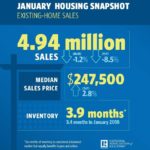The sale of existing homes fell to a seasonally adjusted annual rate of 4.94 million, or 1.2 percent, in January compared with December.
[caption id="attachment_10266" align="alignleft" width="320"] January 2019 Housing Snapshot[/caption]
January 2019 Housing Snapshot[/caption]
Sales are now down from an annual rate of 5.4 million, or 8.5 percent, compared with the same period in 2018 year ago, according to National Association of Realtors. Of the four major U.S. regions, only the Northeast saw an uptick in sales activity last month.
"Existing home sales in January were weak compared to historical norms; however, they are likely to have reached a cyclical low,” said Lawrence Yun, NAR's chief economist “Moderating home prices combined with gains in household income will boost housing affordability, bringing more buyers to the market in the coming months." Although last month’s home sales were the lowest since November 2015, he doesn’t expect the numbers to decline further going forward.
The median existing-home price for all housing types in January was $247,500, up 2.8 percent from January 2018 ($240,800). January's price increase marks the 83rd straight month of year-over-year gains.
[adbutler zone_id="326324"]
[adbutler zone_id="326327"]
The median home price growth is the slowest since February 2012, and he is cautious the figures don’t tell the full story for the month of January. "Lower mortgage rates from December 2018 had little impact on January sales; however, the lower rates will inevitably lead to more home sales."
Total housing inventory, at the end of January increased to 1.59 million, up from 1.53 million existing homes available for sale in December, an increase from 1.52 million a year ago. Unsold inventory is 3.9-month supply at the current sales pace, up from 3.7 months in December and from 3.4 months in January 2018.
Properties remained on the market for an average of 49 days in January, up from 46 days in December and 42 days a year ago. Thirty-eight percent of homes sold in January were on the market for less than a month.
While inventory grew (on a year-over-year basis) for the sixth straight month, Yun thinks the market is still suffering from an inventory shortage. "In particular, the lower end of the market is experiencing a greater shortage, and more home construction is needed," says Yun. "Taking steps to lower construction costs would be a tremendous help. Local zoning ordinances should also be reformed, while the housing permitting process must be expedited; these simple acts would immediately increase homeownership opportunities and boost local economies."
First-time buyers were responsible for 29 percent of sales in January, down from last month (32 percent), but the same as a year ago. All-cash sales accounted for 23 percent of transactions in January, up from December and a year ago (22 percent in both cases). Individual investors, who account for many cash sales, purchased 16 percent of homes in January, up from 15 percent in December, but down from a year ago (17 percent).
Distressed sales--foreclosures and short sales--represented 4 percent of sales in January, up from 2 percent last month and down from 5 percent a year ago. One percent of January sales were short sales.
Single-family home sales sit at a seasonally adjusted annual rate of 4.37 million in January, down from 4.45 million in December and 8.4 percent below the 4.77 million sales pace from a year ago. The median existing single-family home price was $249,400 in January, up 3.1 percent from January 2018.
Existing condominium and co-op sales were recorded at a seasonally adjusted annual rate of 570,000 units in January, up 3.6 percent from last month and down 9.5 percent from a year ago. The median existing condo price was $233,000 in January, which is up 0.1 percent from a year ago.
January existing-home sales in the Northeast increased 2.9 percent to an annual rate of 700,000, 1.4 percent below a year ago. The median price in the Northeast was $270,000, which is up 0.4 percent from January 2018.
In the Midwest, existing-home sales fell 2.5 percent from last month to an annual rate of 1.16 million in January, down 7.9 percent overall from a year ago. The median price in the Midwest was $189,700, which is up 1.4 percent from last year.
Existing-home sales in the South dropped 1.0 percent to an annual rate of 2.08 million in January, down 8.4 percent from last year. The median price in the South was $214,800, up 2.5 percent from a year ago.
Existing-home sales in the West dipped 2.9 percent to an annual rate of 1.00 million in January, 13.8 percent below a year ago. The median price in the West was $374,600, up 2.9 percent from January 2018.